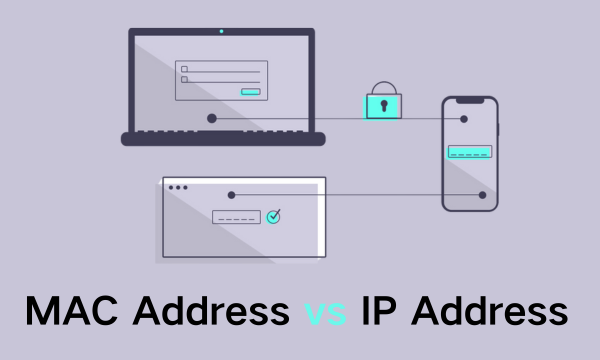MAC Address vs IP Address: Understanding the Difference
 BrowserScan
BrowserScan
What is A MAC Address
Every device that connects to the internet, like your computer or smartphone, has a special identification number—this is the "MAC address." It acts as a permanent tag, helping the internet know where to deliver data. Composed of 12 alphanumeric characters, this address is typically divided into six pairs, which may be separated by colons, dashes, or not separated at all. For instance, "00-B0-D0-64-C1-36" is an example of a MAC address.
The MAC address is set by the manufacturer when the device is made, akin to the "place of birth" information on your birth certificate, which is why it's sometimes referred to as a "hardware address" or "physical address." This address is usually embedded in a small chip on the device, much like the information on your ID card is hard to alter.

The OUI is the first half of the MAC address, typically the first six characters (such as "00:A0
" for Intel). This part of the address identifies the manufacturer or organization that created the network interface card. Since organizations must register to get an OUI, this section of the MAC address can be used to trace the device back to the company that made it.
The second half of the MAC address is the NIC, which is assigned by the manufacturer. This part is unique to each individual device that the manufacturer produces. It's akin to a unique serial number that, when combined with the OUI, ensures that every networked device has a distinct MAC address.
In essence, the MAC address's OUI portion tells you who made the card, and the NIC portion tells you which specific card it is. Together, they create a unique identifier that allows for precise device recognition on a network.
What is An IP Address
An IP (Internet Protocol) address is a unique set of numbers that identifies a device on the internet or a local network. It's like a mailing address, but for computers and other devices.
The traditional IP address, called IPv4, has four sets of numbers separated by periods. An example is "192.168.1.1". Each set of numbers can go from 0 to 255. This system has been around for a long time, but because it allows for about 4 billion unique addresses, we are running out due to the huge number of devices now online.
To solve this, IPv6 was created. It's a newer system that has a lot more numbers and letters in it. An example of an IPv6 address is "2001:0db8:85a3:0000:0000:8a2e:0370:7334". This kind of address is much longer and uses hexadecimal (base 16) numbers, which means it can provide a virtually unlimited number of unique IP addresses.
IPv4 and IPv6 are not directly compatible, but there are ways to make them work together. This is important because the world is slowly moving from IPv4 to IPv6. IPv6 doesn't just offer more addresses; it also improves the efficiency and security of the network.
Each device on a network has a unique IP address, and when you want to visit a website, your computer uses that site's IP address to find it. It's like using a GPS to get to a friend's house by entering their street address. The IP address ensures that the information you request, like a webpage, finds its way to your computer and not someone else's.
If you want to learn more about IP addresses, you can read this article
How MAC Address and IP Address Work
When a computer, tablet, and smartphone are connected to a home Wi-Fi network, they each obtain an internal IP address from the router. This internal IP is unique to each device within the local network and is used by the router to identify the source and destination of the network traffic within the network.
As these devices communicate with the internet, the router uses Network Address Translation (NAT) to allow multiple devices to share a single public IP address, which is the one assigned by the Internet Service Provider. When a device sends an outbound request, the router translates the internal IP address to the public IP address and keeps track of this translation using a NAT table that maps internal IP addresses and specific port numbers to the shared public IP address. This mapping is crucial because it allows the router to maintain the state of each individual connection.
When data is sent back from the internet to the public IP address, the router examines this NAT table to determine which device on the local network the data is intended for. It looks at the port number included in the packet's header, which was associated with the device's outbound request. Using this information, the router then directs the incoming data to the correct device by translating the public IP address back to the corresponding internal IP address. This process allows each device to communicate with the internet as if it were directly connected, all while using a single public IP address.
What are the Differences Between MAC and IP Address
Layer of Operation: A MAC address functions at the data link layer, facilitating communication within a local network, while an IP address operates at the network layer, enabling devices to connect across different networks on the internet.
Format: MAC addresses are 48-bit hexadecimal numbers, typically displayed in six groups separated by colons, whereas IP addresses come in two versions: IPv4 addresses are 32-bit numbers shown in four decimal groups, and IPv6 addresses are 128-bit hexadecimal numbers displayed in eight groups.
Assignment: The MAC address of a device is permanent and factory-assigned to its network interface card, making it a physical address, while an IP address can be either statically assigned by an administrator or dynamically assigned by a DHCP server.
Purpose and Usage: MAC addresses are critical for the local delivery of data packets on a network, while IP addresses are used to identify devices and ensure data packets are routed correctly across the entire internet.
Scope: A MAC address is only relevant and used within a local network environment and doesn't travel beyond routers, while an IP address is utilized for global communication and can traverse multiple networks.
Visibility and Propagation: In the journey of a data packet, the MAC address is primarily used and visible within its originating network and changes as it passes through routers, but the IP address remains the same from source to destination.
Changeability: Although a MAC address is generally fixed to a device's hardware, it can be spoofed, whereas an IP address is much more flexible and can be easily changed or reassigned.
Conflict Resolution: MAC address conflicts are extremely rare due to their unique manufacturer assignments, while IP address conflicts are more common but can be resolved through network reconfiguration or the use of DHCP.
Frequently Asked Questions
Can websites obtain my MAC address?
No, websites cannot access your MAC address. When you connect to a website, your MAC address does not travel beyond your local network. Only your IP address is visible to websites for communication purposes.
Is it possible for two devices to have the same IP address?
Yes, two devices can have the same private IP address if they are on different local networks. However, on the internet, each device must have a unique public IP address, which is often managed by a router using NAT (Network Address Translation).
Can a device have multiple IP addresses?
Yes, a single device can have multiple IP addresses. This is common when a device is connected to different networks, has multiple network interfaces, or uses both IPv4 and IPv6 addresses. For example, a laptop connected to Wi-Fi and Ethernet simultaneously may have different IP addresses for each connection.
How can I find out my own MAC and IP addresses?
On most operating systems, you can find your MAC address by looking at your network settings or by using a command-line tool (like ipconfig on Windows or ifconfig on Unix-based systems). Your IP address can be viewed in your network settings or by visiting a website that displays your public IP address, such as "browserscan.net".
Subscribe to my newsletter
Read articles from BrowserScan directly inside your inbox. Subscribe to the newsletter, and don't miss out.
Written by

BrowserScan
BrowserScan
Am I 100% anonymous? Check your browser fingerprints and IP address to find how your online identity looks👉www.browserscan.net